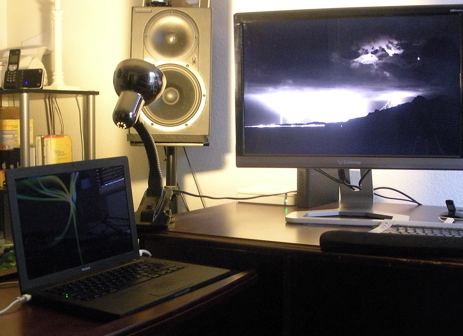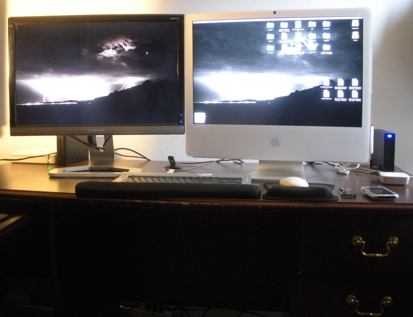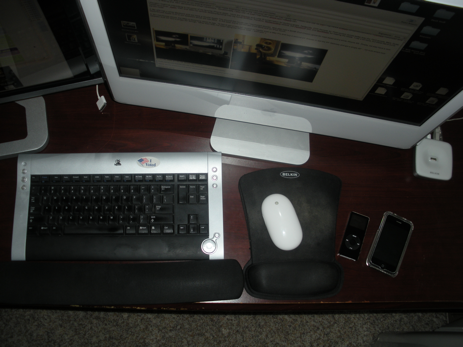Khoi Vinh and Nicholas Felton’s blow-by-blow recap of their stellar, “exhibition” Layer Tennis match from last week.
“Simplicity is hard. Let’s go shopping!” →
What a great and hilarious piece by Mark Pilgrim. (Via Patrick Rhone.)
My Dropbox Referral Link →
If the Dropbox lightbulb just turned on for you too, please consider setting up your new account using this referral link. If you do, then you and I will both get some free extra storage. Sweet deal.
First Thoughts on Dropbox After 24 Hours of Use By a Guy Who Doesn’t Need to Share Files Between Multiple Computers
Dropbox: it’s not just for file sharing anymore. (Based on all the feedback I received through Twitter and email, this is probably not news to any of you. But maybe it is.)
Like I said yesterday regarding dropbox, I have always assumed it was mostly for use to share files between multiple computers via the Cloud. Though it is great for that, Dropbox also makes for a very, very clever real-time syncing solution.
And so two nights ago I moved two very important folders to Dropbox:
- Currently Working On: This is the folder which holds all my current projects. Throughout my day, this is where the vast majority of new documents get put and where the most documents that I’m updating and building get saved.
If I were to have a hard drive failure on my way home from work 95% of the non-recoverable files would exist in this folder since it is where I keep most of my current work in.
- The Wardrobe: This folder is my desktop replacement. It’s where I toss any and all files that are temporary, or I don’t know what to do with them yet.
Combined, these two folders take up less than 1GB of storage. And keeping them in my Dropbox folder means they are now constantly backed up. Not to mention I now have free version control — so in case I accidentally overwrite that Super Important Report I’ve been working on all week, I can save the day by pulling the 2nd-most-recent version right off the Cloud and get back to work.
Christopher Bowns’s Dual-Drive Setup →
Here’s a very clever idea. Christopher swapped out his MacBook Pro’s SuperDrive with a secondary, internal hard drive using the MCE OptiBay. He installed an SSD and set it as his boot disc and still had a 500GB HDD for storage and big file downloads.
I rarely use my optical drive, so having it available via USB just may be a better solution than cloud storage for my files.
Regarding Dropbox, Backups, SSDs, Remote Storage, and my MacBook Pro’s Clicking HDD
Yesterday on Twitter I asked a question:
“Dropbox fans: if I have 20GB worth of files on my Dropbox, do those files also take up 20GB on my laptop’s HDD, too?”
The answer is yes. Files in your Dropbox account which are synced to the files on your computer exist in both places.
Until today my perception was that people use Dropbox to get access to their files from multiple computers. And since all the computer I have is just my trusty laptop, why would I have use for a syncing service? My thought was to use Dropbox as some sort of remote, external storage bucket for files I want to have access to but which I don’t want to take up space on my laptop’s hard drive.
But Dropbox doesn’t roll that way.
However, as I found out tonight, there is another (and seemingly just as popular) use for Dropbox. And that is as a real-time backup. Not a bad idea. Get 2GB of your most important text files, application support folders, or whatever, all synced and backed up (with version control!) for free. More than 2GB starts costing money, unless you have a referral link and can convince your internet friends and strangers to set up an account.
I never considered using Dropbox as a backup solution because I figured I already have a good backup routine: (a) nightly clones to an external drive, via SuperDuper; (b) regular Time Machine backups to the Time Capsule; (c) weekly clones to an off-site drive at my work office. But a real-time, off-site backup of my most frequently changing files is a grande idea.
And so yes, I am now using Dropbox. But not for what I originally had planned.
What did originally prompt my question is that I’ve been considering swapping out my laptop’s HDD for a Solid State Drive. Every now and then I can hear my hard drive clicking, and I have no doubt it’s getting ready to croak.
After reading Marco’s thoughts, and then watching this show and tell by OWC, I’m thinking when the time comes to replace my hard drive it would be fantastic to go SSD. If I pinch my pennies I could pick up one of the new 128GB RealSSDs from Crucial.
I would prefer to get the OWC Mercury Extreme, but as Gruber pointed out earlier today, over 25% of the Mercury Extreme SSD drives are allocated to “enterprise-class real-time data redundancy & error correction”. Even though the OWC drive is $100 cheaper than the Crucial drive, I’m fairly sure I’d rather have access to that 28GB.
However, as Marco stated in his aforelinked article, Intel’s new 25nm are likely to be one half the cost of these current leading SSD drives from Cruicial and Other World Computing.
A 128GB hard drive would cut my laptop’s storage in half. This is something I could definitely survive with — but only if I had relatively easy access to the other 100GB worth of files regardless of my location.
Nine days out of ten I could easily get by with a 100GB drive and still have storage to spare. I spend most of my day communicating through emails, working with text-ish files, and listening to music. For all this, I need access to less than 60GB of what’s on my hard 250GB drive (which is only 200GB full right now).
- The folder with all my work-related files is just barely over 2GB;
- My bloated iTunes music collection of 2,645 songs is 25GB;
- My Applications folder with 125 apps is 15GB;
- And my ~/Home/Library folder is 13GB.
But on day ten of ten, when I have an unanticipated need for That One File, it really needs to be accessible — regardless of where I am.
There are a few other options for remote storage to help ensure I can get to That One File when the need arises every other week or so.
- ExpanDrive, which costs $40 for a license and lets you mount external servers (such as your own hosting server, or an Amazon S3 bucket) to your Mac as if they were USB drives. (Also, Transmit works with Amazon S3.)
-
Back to my Mac, which is part of the $100-per-year MobileMe account. And if you also buy a Time Capsule you can access the files stored on that Time Capsule from anywhere you’ve got internet.
-
A small, light, portable USB drive like the WD Passport.
None of these three remote storage solutions appeal to me. Maybe I should just pray my HDD lasts a little longer, and start saving for a larger SSD drive hoping prices drop in the meantime. That, or massively slim down my music and photo collections.
“Computing Simplicity?” →
Chris Bowler:
But at times, I wonder if [minimal computing] isn’t just the next fad. It’s certainly partly a backlash to the personal productivity movement, with GTD at the centre. But maybe it’s also the new GTD. Instead of doing work, people are still tinkering. But now they do so under the guise of ‘reducing’ or ‘simplifying’. But in the end, it’s the same issue. The boring tasks that you need to do are still on your list.
Chris continues on to make the point that minimalism in computing is not how your computer looks. And he is dead on. Minimalism and simplicity do not necessarily equal clean and tidy; they mean having what you need without excess. If that happens translate into less-than-the-guy-next-to-you, well, then cool. But ultimately it should translate to focus, a release of needless stress, and even into better relationships with the things and people around you.
Pastebot 1.1 →
A nearly-perfect update to an already fantastic iPhone app. Virtually every quibble I had with the 1.0 version is answered in this update. (Thanks Mark and Paul!)
“RIP iPod” →
Sean Sperte on why the iPad spells doom for the iPod lineup as we know it.
Follow shawnblanc.net on Twitter →
Over the past few weeks I have piping this site’s RSS feed over to my personal Twitter account. For years I have only ever posted links to my own site on Twitter when they were major posts which I especially thought were worthy of highlighting.
But the tipping point for me to set up automatic re-posting of links and articles to Twitter came for two reasons:
- I really appreciate it when cool dudes like Marco or Rands tweet links back to their own articles.
-
More and more I have been finding interesting news and good reads via Twitter (some days, more so than what’s in my RSS reader). And even though much of the content I’m finding in Twitter is the same as what’s being delivered to my RSS reader, lately I’ve been interacting with Twitter much more than my RSS feeds.
But there were a couple drawbacks to having this site’s RSS feed systematically re-posted to my personal Twitter account.
- Some folks don’t care a dime about my nerdy posts, but have great concern about what I eat for lunch.
-
Some folks are already subscribed to my RSS feed and would prefer to keep it there and nowhere else.
For those who do want to get this site’s posts in Twitter, it is not hard at all for you to follow another account. And the noise level is identical to what it would be if the posts were coming through my personal account.
So really, the only drawback I see is that I have to start over with a new account. But come on… what a pathetic and prideful excuse.
- Follow the shawnblanc.net RSS feed: @shawnblancnet
- Follow me: @shawnblanc
Share This Post on Twitter
It is surprisingly simple to add a little bit of code to your website to allow for sharing of posts on Twitter.
In WordPress using the_title and the_guid functions you can build a dynamic “retweet” link for each post that works on your home page and on individual post pages.
The code I’m using here looks like this:
<a href="http://twitter.com/home?status=<?php the_title(); ?> - <?php the_guid(); ?> (via @shawnblanc)">Retweet.</a>
The advantage of using the_guid instead of the_permalink is that it’s the shortest URL your WordPress site automatically generates. And assuming you use clean, human-friendly, URLs set in your WordPress preferences, these post ID URLs will simply re-direct to your desired permalink.
For example, below are two different yet legit URLs for my review of Yojimbo. The first one is what’s generated using the_guid and the second is the actual permalink URL and is what’s generated using the_permalink.
The second link, which is the standard, permalink address to the Yojimbo article is more human friendly and makes for better search results. However, it also has 29 more characters than the first link listed. The second link is best for normal use, the first is best for Twitter.
What I like about this way of implementing a Twitter-sharing feature is that it uses plain and simple code, rather than a plugin. Plugins are great, but I like to keep their usage here to a minimum.
I have yet to see anyone really use these Twitter-sharing links yet. In the past few weeks of testing this, I’ve seen amongst my own little readership that people are much more inclined to re-tweet something already tweeted. Which leads me to my next point…
I have added the shawnblanc.net RSS feed to my Twitter using Alex King’s Twitter Tools plugin. Which means all new posts (articles and links) on shawnblanc.net are automatically tweeted. (Example.)
For months now I have been finding the most interesting news and best reads via Twitter (much more than via my RSS feeds). Even though much of the content I’m being told about in Twitter is the same content that’s being delivered to my RSS reader, I interact with Twitter much more than my RSS feeds.
And so I assume it’s more than likely that you’re doing the same. There will certainly some overlap for those of you who follow me on Twitter and get my RSS feed, and if that bugs you I am sorry. Nearly every RSS feed I am subscribe to I also follow the author on Twitter, And I have never once been bugged to see them plug their own content.
“Quack” →
What a great short story by Jeffery Zeldman.
Reader’s Setup: Johnny Wey
Johnny Wey is a software engineer from Denver, Colorado, working in the Java, web, and Mac/iPhone development spaces.
Johnny’s Setup
1. What does your desk look like?



2. What is your current Mac setup?
My current Mac setup consists of a 24″ 2.33GHz Core 2 iMac with a second Gateway 24″ display desktop and a 2.4GHz black MacBook. The iMac has 3GB of RAM and the MacBook has 4.
I store all of our iTunes media on a 1TB external Firewire 800 drive (seen on the right of the iMac). This and the rest of the iMac’s data are backed up to a 1.5TB Time Capsule (I replaced the 1TB drive with a 1.5TB when we started running out of disk space). My Macbook and my wife’s Macbook are backed up to a 500GB external drive attached to the Time Capsule (seen just behind the Gateway monitor).
On the iPod/iPhone front I have a black 16GB iPhone 3G and a first-gen iPod Nano / Nike+ kit that I use for running.
My keyboard is from the Logitech diNovo Cordless Desktop package and the mouse is a standard Apple wireless Mighty Mouse. I also have two HR824 Mackie speakers that I previously used for amateur music production in Pro Tools, but I kept them around because they make iTunes BUMP!
Located just to the right of the iMac in front of the iTunes drive is a Belkin FSU233 4-port USB hub that I chose initially because it matched the iMac but fell in love with when I started using the top USB slot for Skype headsets, media card readers, and just about every other sort of temporary USB connection (I tried to find a link to this, but Belkin’s site doesn’t seem to have it anymore).
Not shown is an Airport Extreme that I use for a dual-band radio (keep 802.11n and 802.11g on their own respective routers), an HP all-in-one, and two Apple TVs: one in the living room and one in the bedroom.
3. Why are you using this setup?
I use this setup for all sorts of different things, from software development to playing in Pro Tools. And the desktop/laptop combination fits me pretty well.
I initially thought I might be able to get away with dumping the iMac and just having a MacBook, but I like the breathing room the two, 24″ displays gives me and finding a good backup/sharing solution for all the media and other data we have that doesn’t involve a desktop computer was a challenge.
This setup gives me a good dose of both worlds and allows sharing everything on the iMac with our MacBooks, the Apple TVs around the house, and just about anything else we might want to stream data to.
I keep the iMac and MacBook in sync using MobileMe and a central Git repository on the iMac that I have exposed with SSH for keeping code for various projects in sync.
The only thing I’d change is perhaps a new iMac some time in the near future. The 2.33GHz is starting to show its age and having a 3GB memory limitation makes virtualization a bit of a chore.
4. What software do you use on a daily basis, and for what do you use it?
On a daily basis, I use Mail.app, iTunes, Safari, NetNewsWire, Adium, CoverSutra, Twitterrific, and iCal (these are open just about all the time).
On a (mostly) daily basis, I use IntelliJ for Java development, TextMate for Grails/Groovy development (and just about any other text related task), XCode for iPhone/Mac development, Photoshop CS4 for image/icon manipulations and some UI prototyping, Firefox for web debugging, Taskpaper as a simple GTD app, and iPhoto to, uh, look at photos.
I also make extensive use of the Terminal (so much so that I rarely use Finder) and use VMWare Fusion fairly often for IE testing and .NET development when necessary. Occasionally, I also use Skype.
I thought it might be interesting to list some of my favorite iPhone apps: I love the combination of iFitness and Lose It! for meeting my workout goals; Twitterrific; DVR Remote for TIVO control (works better than the TIVO remote, IMO); Guitar Toolkit as a tuner; Jaadu VNC and iSSH for remote desktop/terminal into my home desktop; Pandora; NetNewsWire mobile; the Facebook app; and BeatMaker for making the beatz. (I use a lot more apps, but these stand out to me the most.)
5. Do you own any other Mac gear?
My wife has a white MacBook and we have a couple Apple TVs around the house (as I mentioned above). She also has a 30GB iPod Classic (great for road trips!) and a white 16GB iPhone 3G. Finally, we also have a now-discontinued Apple Hi-Fi in our bedroom which we use daily. In the past, we’ve owned two iPod Minis and an iPod Touch.
6. Do you have any future upgrades planned?
As I mentioned above, the iMac is starting to show its age. I’d like to get a new iMac or maybe even a Mac Pro and buy a second 24″ display or sell the 24″ Gateway and get a single 30″ … not sure what’s best between dual 24″ and a single 30″ though. Other than that, I’ve been eying the iPhone 3GS… We’ll see.
More Sweet Setups
Johnny’s setup is just one in a series of sweet Mac Setups.
